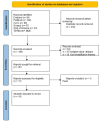A scoping review of stroke rehabilitation in Africa: interventions, barriers, and research gaps
- PMID: 40640909
- PMCID: PMC12247302
- DOI: 10.1186/s41043-025-01004-z
A scoping review of stroke rehabilitation in Africa: interventions, barriers, and research gaps
Abstract
Stroke is a leading cause of disability worldwide, with low- and middle-income countries (LMICs), particularly in Africa, experiencing an increasing burden due to rising incidences driven by urbanization, lifestyle changes, and non-communicable diseases. This scoping review maps stroke rehabilitation interventions in Africa, identifying barriers to implementation and adherence, and highlighting research gaps to inform future policy and clinical practices. A literature search was conducted across PubMed, Scopus, Web of Science, Embase, and African Journals Online (AJOL), supplemented by grey literature from WHO reports and government publications. Inclusion criteria focused on studies of stroke rehabilitation interventions in African countries, targeting adults diagnosed with stroke, and included randomized controlled trials, cohort studies, qualitative studies, and systematic reviews. Findings indicate that stroke rehabilitation interventions in Africa, including physical therapy, task-specific training, psychoeducational programs, tele-rehabilitation, mobile phone-supported interventions, and programs targeting activities of daily living (ADLs), are implemented in some settings to enhance functional independence, motor, cognitive, and speech functions, and psychological well-being. However, adherence to these protocols is often limited by significant barriers, including financial constraints, geographical and transportation challenges, a shortage of skilled rehabilitation professionals, cultural and language barriers, and patient-related factors such as cognitive impairments and lack of social support. The review also reveals variability in the availability of standardized rehabilitation protocols across African settings, with some regions lacking consistent implementation. Research gaps include insufficient epidemiological data, limited evaluation of cost-effective and culturally appropriate rehabilitation models, and underexplored caregiver burden. This review advocates further studies on technology integration, community-based rehabilitation, and culturally tailored interventions to improve adherence and accessibility. It also emphasizes addressing systemic and infrastructural barriers to ensure equitable access to rehabilitation services for stroke survivors across Africa. Future research should focus on optimizing rehabilitation strategies, reducing long-term disability, and improving quality of life for stroke survivors in Africa.
Keywords: Africa; Barriers; Low- and middle-income countries; Rehabilitation interventions; Stroke rehabilitation.
© 2025. The Author(s).
Conflict of interest statement
Declarations. Ethics approval: Not applicable. Consent to participate: Not applicable. Consent for publication: Not applicable. Competing interests: The authors declare no competing interests.
Similar articles
-
The Role of Speech and Language Therapists (SLTs) in International Stroke Teams: A Systematic Review.Int J Lang Commun Disord. 2025 Jul-Aug;60(4):e70062. doi: 10.1111/1460-6984.70062. Int J Lang Commun Disord. 2025. PMID: 40536137 Free PMC article. Review.
-
Interventions for preventing abuse in the elderly.Cochrane Database Syst Rev. 2016 Aug 16;2016(8):CD010321. doi: 10.1002/14651858.CD010321.pub2. Cochrane Database Syst Rev. 2016. PMID: 27528431 Free PMC article.
-
Barriers and facilitators to the implementation of lay health worker programmes to improve access to maternal and child health: qualitative evidence synthesis.Cochrane Database Syst Rev. 2013 Oct 8;2013(10):CD010414. doi: 10.1002/14651858.CD010414.pub2. Cochrane Database Syst Rev. 2013. PMID: 24101553 Free PMC article.
-
Health professionals' experience of teamwork education in acute hospital settings: a systematic review of qualitative literature.JBI Database System Rev Implement Rep. 2016 Apr;14(4):96-137. doi: 10.11124/JBISRIR-2016-1843. JBI Database System Rev Implement Rep. 2016. PMID: 27532314
-
Caregiver-mediated exercises for improving outcomes after stroke.Cochrane Database Syst Rev. 2016 Dec 21;12(12):CD011058. doi: 10.1002/14651858.CD011058.pub2. Cochrane Database Syst Rev. 2016. PMID: 28002636 Free PMC article.
References
Publication types
MeSH terms
LinkOut - more resources
Full Text Sources
Medical


